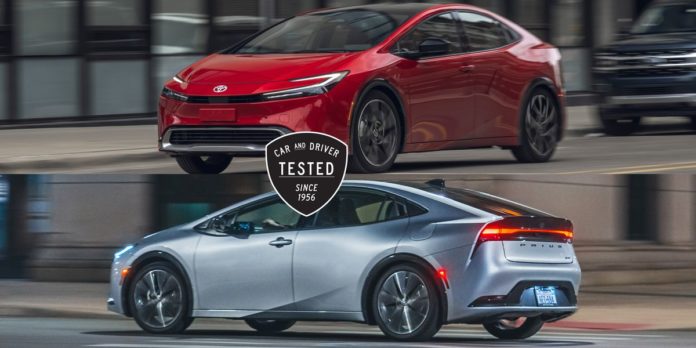- We tested the Toyota Prius hybrid and Prius Prime plug-in hybrid, and here we’re diving into the numbers.
- The standard Prius gets better fuel economy on the highway, but the Prime offers 33 miles of EV range.
- The 220-hp Prius Prime is also the quicker of the two in terms of acceleration.
Welcome to Car and Driver’s Testing Hub, where we zoom in on the test numbers. We’ve been pushing vehicles to their limits since 1956 to provide objective data to bolster our subjective impressions (you can see how we test here).
Toyota’s new Prius is undoubtedly a hit, bringing flashy new styling and far more performance to the venerable gas-electric hatchback. It even won a Car and Driver 10Best Cars award for 2024. But while the Prius is clearly much-improved compared with its predecessor, there’s a lot more than that to consider about the new model. Most importantly, there’s the choice between the standard Prius hybrid and the Prius Prime plug-in hybrid.
What are the pros and cons of each Prius? While they share styling, interior components, and technology features, the Prius and the Prius Prime have different powertrains and batteries. One also can be plugged into a charger and the other cannot. Here, we’re using our test results to illustrate the differences between the two.
Acceleration and Performance
The Prius Prime has more power than the standard Prius, with a total output of 220 horsepower versus the non-Prime’s 194 hp in front-wheel-drive form or 196 hp in all-wheel-drive form (the Prime is FWD-only). Despite the Prime being 307 pounds heavier than the standard Prius, due to its larger battery pack, the burlier plug-in version is quicker in our acceleration tests. It hit 60 mph in 6.5 seconds versus the FWD Prius’s 7.1-second result.
The standard model’s lighter weight paid dividends in our handling and braking tests, however. The Prius Prime grips the skidpad at 0.84 g and stops from 70 mph in 179 feet, while the standard Prius beats those numbers with an 0.87 g skidpad result and a 70-mph stop of 194 feet.
Fuel Economy and Range
In our real-world 75-mph highway fuel-economy testing, the standard Prius was thriftier than the Prime, achieving 49 mpg versus the Prime’s 46 mpg. The standard Prius also has a slightly larger fuel tank than the Prime, meaning it can travel further between fill-ups.
For the Prime, that highway fuel-economy number applies when the battery is depleted and the vehicle is running in hybrid mode. The real advantage of the plug-in hybrid, though, is its electric-only range. The Prius Prime we tested had a real-world range of 33 miles on a full charge.
Is the Plug-In Hybrid Worth It?
The price difference between the two Prius hybrids is significant, with the standard model coming in just under $30,000 ($29,045 to be exact). The Prime starts at $34,070. If you’re trying to decide whether to pony up the extra several thousand dollars for the plug-in model, there are several factors to consider.
- Do you have a charging setup at home? If so, you’ll be able to take far better advantage of the Prime’s EV range. If not, you’ll have to rely on public charging stations, which may mean you aren’t able to charge the vehicle as often.
- How far is your commute? If your daily driving routines fit within the Prius Prime’s electric range, then you’ll be able to do a lot of your driving without using a drop of gasoline, provided you can charge at home or at work.
- Do you want all-wheel drive? If yes, then you can cross the Prime off the list, because it’s offered only with front-wheel drive.
Despite being raised on a steady diet of base-model Hondas and Toyotas—or perhaps because of it—Joey Capparella nonetheless cultivated an obsession for the automotive industry throughout his childhood in Nashville, Tennessee. He found a way to write about cars for the school newspaper during his college years at Rice University, which eventually led him to move to Ann Arbor, Michigan, for his first professional auto-writing gig at Automobile Magazine. He has been part of the Car and Driver team since 2016 and now lives in New York City.






